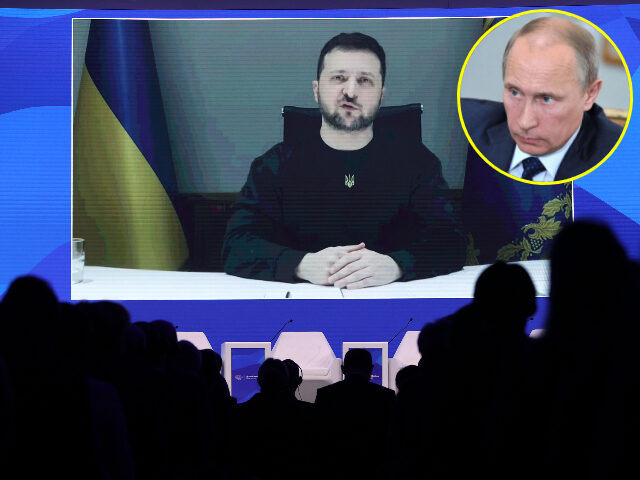Ukraine marked the 37th anniversary of the Chernobyl nuclear disaster, widely considered the worst event of its kind in human history, on Wednesday, condemning Russia’s ongoing invasion of the country and accusing it of using nuclear threats to “blackmail” the world.
Ukrainian President Volodymyr Zelensky attended a memorial event for the victims of the disaster – an event that did not appear to occur last year, in the early days of the Russian “special operation” to oust Zelensky – and issued a statement urging the world to unite against “terrorist state” Russia to prevent a similar situation in the future.
“Thirty-seven years ago the Chernobyl nuclear power station disaster left a giant scar on the whole world,” Zelensky said on Wednesday. “The radiation leak turned a once cozy and developed area into an exclusion zone. Today, the 30-kilometer zone around the Chornobyl nuclear power plant remains a dangerous place with a high concentration of radiation.”
“Last year, the occupying power did not just invade this power station. It again put the world in danger,” Zelensky continued. “We have to do everything to prevent the terrorist state from using nuclear power stations to blackmail Ukraine and the world.”
On April 26, 1986, the communist government in then-Soviet Ukraine caused the Chernobyl nuclear disaster by severely mismanaging a test at the site’s nuclear plant. As author Richard Rhodes described in his book Nuclear Renewal:
Engineers with no knowledge of reactor physics were interested to see if they could draw electricity from the turbine generator of the Number 4 reactor unit to run water pumps during an emergency when the turbine was no longer being driven by the reactor but was still spinning inertially. The engineers needed the reactor to wind up the turbine; then they planned to idle it to 2.5 percent power.
[…]
When the experimenters finally started, they felt pressed to make up for lost time, so they reduced the reactor’s power level too rapidly. That mistake caused a rapid buildup of neutron-absorbing fission by products in the reactor core, which poisoned the reaction. To compensate, the operators withdrew a majority of the reactor’s control rods, but even with the rods withdrawn, they were unable to increase the power level to more than 30 megawatts, a low level of operation at which the reactor’s instability potential is at its worst and that the Chernobyl plant’s own safety rules forbade.
The Chernobyl plant was situated near the town of Pripyat, built for plant workers and housing about 50,000 people at the time. The Soviet government evacuated Pripyat residents belatedly and left them largely uninformed about the situation; most were not told they would never return home.
The Soviet government also failed to inform the international community about the incident despite the radioactive fallout spreading throughout much of Europe. Scientists estimate that 8.4 million people in the region were exposed to high levels of radiation as a result of the disaster.
Soviet officials claim that only about 30 died in the immediate aftermath of the explosions at the power plant, but the true death toll of the disaster remains a matter of intense dispute. The World Health Organization (W.H.O.) estimates that the true death toll is closer to 4,000, including people dying of cancers related to radiation exposure and other illnesses. Neighboring Belarus, in particular, experienced a surge in births of children with significant health defects, in particular heart conditions, that some medical experts have blamed on the disaster, though no universal consensus exists on just how many of these incidents are directly tied to Chernobyl.
The abandonment of the immediate area around the plant, known as the Chernobyl Exclusion Zone, has resulted in dramatic natural growth. After 37 years, visitors can tour Pripyat, but in a short day visits under close government scrutiny to minimize radiation exposure. In 2019, his first year in office, Zelensky lamented that the region had become “a negative part of Ukraine’s brand” and promised to develop a “green corridor” for travel to the area. On the 35th anniversary of the disaster two years ago – before the expanded Russian invasion of the country, Zelensky announced plans to turn the exclusion zone into “an area of renaissance.” Zelensky’s government has advocated for the United Nations to declare the exclusion zone a World Heritage Site and prominently featured it in its 2021 entry to the Eurovision Song Contest. As the 2022 winner, Ukraine won hosting rights over the contest for 2023, but ceded them to the United Kingdom as a result of the war.
Zelensky made no such promises to return tourism to Chernobyl on Wednesday, instead prioritizing the protection of the site from the ongoing war. Russian troops seized Chernobyl in late February 2022, but rapidly lost control of the area as the fighting moved further south.
“It’s been more than a year after the liberation [of Chernobyl] already, scientific and security enterprises in the Chornobyl zone have already returned to normal operation,” Zelensky assured this year.
Much of the concern surrounding potential nuclear disaster as a result of the war is now focused on the Zaporizhzhia Nuclear Plant, located in territory that Russian leader Vladimir Putin “annexed” in September.
“Today, Russia’s barbaric attacks near the nuclear facilities of Ukraine, the occupation of the Zaporizhzhia NPP [Nuclear Power Plant] and its transformation into a military base put the world at risk of a new disaster, the scale of which may exceed the accident at the Chornobyl NPP,” Ukrainian Prime Minister Denys Shmyhal warned on Wednesday.
The U.N. watchdog International Atomic Energy (IAEA) also announced on Wednesday, following a phone call between Zelensky and IAEA chief Rafael Grossi, that it would expand humanitarian support to the country through medical aid for nuclear power plant workers.

COMMENTS
Please let us know if you're having issues with commenting.